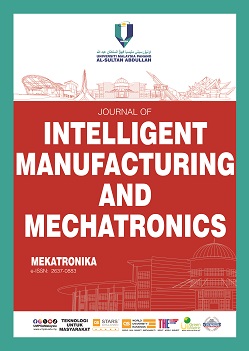Numerical Model Validation of Cyclone Separator with Square Cross-sectional Vortex Finder for Oil Palm Loose Fruit Collection
DOI:
https://doi.org/10.15282/mekatronika.v6i2.10801Keywords:
computational fluid dynamics, cyclone separator, discrete phase model', reynold's stress model, oil palm loose fruitAbstract
Cyclone separators are commonly employed in the industry for material separation because of their practicality. For the exact reason, the technology was expanded to harvest oil palm loose fruits. However, there is a scarcity of data in the utilization of computational fluid dynamics (CFD) in the field. Hence, a numerical model validation is essential in determining the model accuracy in representing flow of cyclone separators Consequently, the current study aims to validate the numerical model with experimental data on factors such as pressure drop, tangential velocity and axial velocity. Results indicate that the model behaves at a satisfactory level with minor errors. Upon successfully validating the numerical model, Reynold’s Stress Model (RSM) and Discreet Phase Model (DPM) were used to simulate an oil palm loose fruit collecting system where density 995.7 and size 0.04 was set to simulate oil palm loose fruits in the system. Turbulence intensity at the gas and particles outlet are specified at 5%. It was found that Rankine vortex was present in the system, confirming the working principal of the cyclone separator. Further optimization works was conducted by modifying the cyclone’s separator configuration to a square vortex finder where a collection efficiency of 92.08 % was recorded.
References
[1] Khalid, M. R. & Shuib, A. R. (2017). Performance of oil palm loose fruits separating machine. Journal of Oil Palm Research. Vol. 29 (3). pp. 358-365. https://doi.org/10.21894/jopr.2017.2903.08
[2] Shuib, A.R., Khalid, M.R., Deraman, M.S. & Mohamed, A. (2012). Oil Palm Loose Fruit Collector No.505, MPOB Information Series No.57, Malaysia Palm Oil Board (MPOB), Selangor.
[3] Park, D. & Go, J. (2020). Design of Cyclone Separator Critical Diameter Model Based on Machine Learning and CFD. Processes. 8. 10.3390/pr8111521.
[4] Wang, L. 2004, Theoretical study of cyclone design, Doctoral Thesis, Texas A&M University.
[5] Safikhani, H., Akhavan-Behabadi, M. A., Shams, M. & Rahimyan, M.H. (2010). Numerical simulation of flow field in three types of standard cyclone separators. Advanced Powder Technology. Volume 21. Issue 4. pp. 435-442,
[6] El-Emam, M. A., Zhou, L., Shi, W. & Han, C. (2021). Performance evaluation of standard cyclone separators by using CFD–DEM simulation with realistic bio-particulate matter. Powder Technology. Volume 385. pp. 357-374. https://doi.org/10.1016/j.powtec.2021.03.006
[7] Fu, S., Zhou, F., Sun, G., Yuan, H. & Zhu, J. (2021). Performance evaluation of industrial large-scale cyclone separator with novel vortex finder. Advanced Powder Technology. 32. pp. 931–939. https://doi.org/10.1016/j.apt.2021.01.033
[8] Wasilewski, M., Brar, L. & Ligus, G. (2020). Experimental and numerical investigation on the performance of square cyclones with different vortex finder configurations. Separation and Purification Technology. 239. 116588
[9] Sakin, A., Karagov, I. & Avci., A. (2019). Performance analysis of axial and reverse flow cyclone separators. Chemical Engineering and Processing - Process Intensification. Volume 144. https://doi.org/10.1016/j.cep.2019.107630.
[10] Parvaz, F., Hosseini, S. H., Elsayed, K. & Ahmadi, G. (2018). Numerical investigation of effects of inner cone on flow field, performance and erosion rate of cyclone separators. Separation and Purification Technology. 201. pp. 223-237.
[11] Wei, Q., Sun, G. Gao, C. (2020). Numerical analysis of axial gas flow in cyclone separators with different vortex finder diameters and inlet dimensions. Powder Technology. Volume 369. pp. 321-333. https://doi.org/10.1016/j.powtec.2020.05.038
[12] Kumar, V. Jha, K. (2019). Multi-objective shape optimization of vortex finders in cyclone separators using response surface methodology and genetic algorithms. Separation and Purification Technology. Volume 215, pp. 25-31. https://doi.org/10.1016/j.seppur.2018.12.083
[13] Elsayed, K. & Lacor, C. (2013). The effect of cyclone vortex finder dimensions on the flow pattern and performance using LES. Computers & Fluids. Volume 71. pp.224-239. https://doi.org/10.1016/j.compfluid.2012.09.027
[14] El-Batsh. H. M. (2013). Improving cyclone performance by proper selection of the exit pipe. Applied Mathematical Modelling. Volume 37. Issue 7. pp. 5286-5303. https://doi.org/10.1016/j.apm.2012.10.044
[15] Yao, Y., Shang, M., Ke, X., Zhang, J., Huang, Z, Zhou, T., & Lyu. J. (2024). Design of multi-stage contracted inlet duct for cyclone separators, Separation and Purification Technology. Volume 332. 125753. https://doi.org/10.1016/j.seppur.2023.125753.
[16] Surahmanto, F., Pamungkas, A., Dhimas, A. M., Soemawidagdo, A. L., Sasongko, B. T., Sukardi, S., Lutfianto, R. & Pratama Hakim, M. R. (2024). Performance Evaluation of Square Cyclones Separator with Cone Geometry Variations. CFD Letters. Volume 16. No. 7:July. https://doi.org/10.37934/cfdl.16.7.136149.
[17] Babaoğlu, N. & Parvaz, F., Hosseini, S. H., Elsayed, K. & Ahmadi, G. (2021). Influence of the inlet cross-sectional shape on the performance of a multi-inlet gas cyclone. Powder Technology. 384. pp. 82-99.
[18] Yu, G., Dong, S., Yang, L., Yan, D., Dong, K., Wei, Y. & Wang, B. (2021). Experimental and numerical studies on a new double-stage tandem nesting cyclone. Chemical Engineering Science. Volume 236. 116537.
[19] Gao, Z. & Wang, J., Liu, Z., Wei, Y., Wang, J. & Mao, Y. (2020). Effects of different inlet structures on the flow field of cyclone separators. Powder Technology. 372. pp. 519-531.
[20] Misiulia, D. & Antonyuk, S., Andersson, A., Lundström, T. (2020). High-efficiency industrial cyclone separator: A CFD study. Powder Technology. 364. pp. 943-953.
[21] Qiang, L., Wang, J. Xu, W. & Meng, Z. (2020). Investigation on separation performance and structural optimization of a two-stage series cyclone using CPFD and RSM, Advanced Powder Technology, Volume 31, Issue 9, pp. 3706-3714.
[22] Shastri, R. & Brar, L. (2020). Numerical investigations of the flow-field inside cyclone separators with different cylinder-to-cone ratios using large-eddy simulation. Separation and Purification Technology. 249. 117149. https://doi.org/10.1016/j.seppur.2020.117149
[23] Nassaj, O. R., Toghraie, D. & Afrand, M. (2019). Effects of multi inlet guide channels on the performance of a cyclone separator. Powder Technology. Volume 356. pp. 353-372.
[24] Erol, H.I., Turgut, O. & Unal, R. Experimental and numerical study of Stairmand cyclone separators: a comparison of the results of small-scale and large-scale cyclones. Heat Mass Transfer 55, 2341–2354 (2019). https://doi.org/10.1007/s00231-019-02589-y
[25] Yohana, E., Tauviqirrahman, M., Putra, A. R., Ade, E. D. & Choi, K. H. (2018). Numerical analysis on the effect of the vortex finder diameter and the length of vortex limiter on the flow field and particle collection in a new cyclone separator. Cogent Engineering. 5:1. 1562319
[26] Siadaty, M., Kheradmand, S. & Ghadiri, F. (2017). Study of inlet temperature effect on single and double inlets cyclone performance. Advanced Powder Technology. Volume 28. Issue 6. pp. 1459-1473.
[27] Misiulia, D., Andersson, A. & Lundström, T. (2017). Effects of the inlet angle on the collection efficiency of a cyclone with helical-roof inlet. Powder Technology. 305. pp. 48-55.
[28] Hamdy, O., Bassily, M. A., El-Batsh, H. M. & Mekhail, T. M. (2017) Numerical study of the effect of changing the cyclone cone length on the gas flow field, Applied Mathematical Modelling. Volume 46. pp. 81-97.
[29] Wasilewski, M. & Duda, J. (2016). Multicriteria optimisation of first-stage cyclones in the clinker burning system by means of numerical modelling and experimental research. Powder Technology. 289. pp. 143-158.
[30] Misiulia, D., Andersson, A. & Lundström, T. (2015). Effects of the inlet angle on the flow pattern and pressure drop of a cyclone with helical-roof inlet. Chemical Engineering Research and Design. Volume 102. pp.307-321.
[31] Li H., Gao B. &Li B., (2015). Numerical Analysis of Flow Dynamics of Cyclone Separator Used for Circulating Fluidized Bed Boiler. Chemical Engineering Transactions, 46.pp.991-996.
[32] Souza, F. J., Salvo, R. V. & Martins, D. M. (2015). Effects of the gas outlet duct length and shape on the performance of cyclone separators. Separation and Purification Technology. Volume 142. pp. 90-100.
[33] Hui Ci, H. & Sun, G. (2015). Effects of Wall Roughness on the Flow Field and Vortex Length of Cyclone. Procedia Engineering. Volume 102. pp. 1316-1325. https://doi.org/10.1016/j.proeng.2015.01.262.
[34] Brar, L., Sharma, R., & Elsayed, K. (2015). The Effect of the Cyclone Length on the Performance of Stairmand High-Efficiency Cyclone. Powder Technology. 286. pp. 668-677.
[35] Elsayed, K. & Lacor, C. (2012). The effect of the dust outlet geometry on the performance and hydrodynamics of gas cyclones. Computers & Fluids. Volume 68. pp. 134-147.
[36] Elsayed, K. & Lacor, C. (2011). The effect of cyclone inlet dimensions on the flow pattern and performance. Applied Mathematical Modelling. Volume 35, Issue 4. pp. 1952-1968.
[37] Elsayed, K. & Lacor, C. (2010). The effect of vortex finder diameter on cyclone separator performance and flow field. V European Conference on Computational Fluid Dynamics. 14-17 June 2010.
[38] Gimbun, J., Chuah, L. A., Choong, T. S. Y. & Fakhru'l-Razi, A. (2005). Prediction of the effects of cone tip diameter on the cyclone performance. Journal of Aerosol Science. 36. pp. 1056-1065.
[39] Hoekstra, AJ., Derksen, JJ., & Van Den Akker, HEA. (1999). An experimental and numerical study of turbulent swirling flow in gas cyclones. Chemical Engineering Science, 54(13-14), pp. 2055-2065.
[40] ANSYS FLUENT Theory Guide, ANSYS, Inc., Release 15.0, November 2013.
[41] Standard for Verification and Validation in Computational Fluid Dynamics and Heat Transfer, The American Society of Mechanical Engineers., R2021, 2009.
[42] Ramdhan, M. K., Rahim, A. S. & Norman, K. (2019). Determination of minimum suction level of collecting oil palm loose fruits. Konvensyen Kebangsaan Kejuruteraan Pertanian dan Makan 2019, Putrajaya. pp. 198-201.
[43] Ahmad, H., Ahmad Zamri, M.Y, & Mohd S. J. (1995). Loose Fruit Collector. PORIM Information Series No.19, Palm Oil Research Institute of Malaysia (PORIM), Selangor.
[44] Owolarafe, O.K., Olabige., M. T., & Faborode., M. O. (2007). Physical and mechanical properties of two varieties of fresh oil palm fruit. Journal of Food Engineering. Volume 78. Issue 4. pp. 1228-1232. https://doi.org/10.1016/j.jfoodeng.2005.12.049
Downloads
Published
Issue
Section
License
Copyright (c) 2024 The Author(s)

This work is licensed under a Creative Commons Attribution-NonCommercial 4.0 International License.




